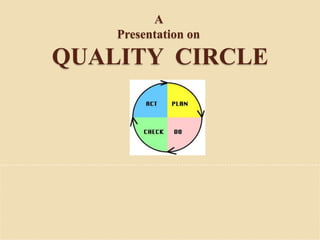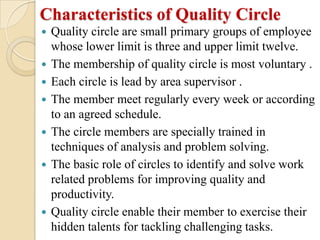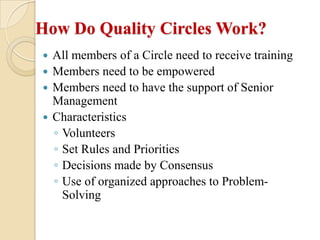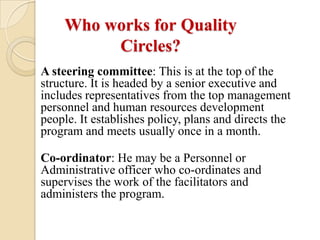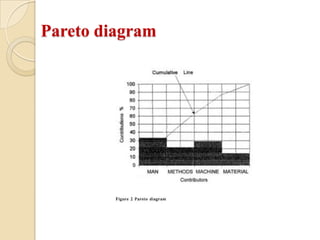Quality circle 2
- 1. A Presentation on QUALITY CIRCLE
- 2. Quality Circle -A way to Quality Improvement INTRODUCTION People are the greatest assets of an organization, because, through people all other resources are converted into utilities. However, management of ‘People Resources’ has always been a vexed problem ever since the beginning of organized human activities. A number of managerial responses have been developed to answer this question.
- 3. DEFINITION Quality Circle is a small group of 6 to 12 employees doing similar work who voluntarily meet together on a regular basis to identify improvements in their respective work areas using various techniques for analyzing and solving work related problems coming in the way of achieving and sustaining excellence leading to mutual upliftment of employees as well as the organization. It is "a way of capturing the creative and innovative power that lies within the work force“
- 4. GENESIS OF QUALITY CIRCLES After the Second World War Japanese economy was in the doldrums, Americans decided to help Japan in improving the quality standards of their products. General Douglas Mac Arthur who, at that time, was the commander of the occupational forces in Japan took up the task of imparting quality awareness among Japanese to help them improve their products and the reliability of manufacturing systems including men, machine and materials. Thus, by 1975, they were topping the world in quality and productivity. This astonishing and unique achievement in modern history became an eye – opener to the world. Industrialists and politicians from all over the world started visiting Japan to know how they have achieved such magical results in such a short span. The answer to this was painstaking and persevering efforts of the Japanese leaders and workers and the development and growth of the philosophy of small working groups.
- 5. Characteristics of Quality Circle Quality circle are small primary groups of employee whose lower limit is three and upper limit twelve. The membership of quality circle is most voluntary . Each circle is lead by area supervisor . The member meet regularly every week or according to an agreed schedule. The circle members are specially trained in techniques of analysis and problem solving. The basic role of circles to identify and solve work related problems for improving quality and productivity. Quality circle enable their member to exercise their hidden talents for tackling challenging tasks.
- 6. CONCEPT The concept of Quality Circle is primarily based upon recognition of the value of the worker as a human being, as someone who willingly activates on his job, intelligence, experience, attitude and feelings. It is based upon the human resource management considered as one of the key factors in the improvement of product quality & productivity. Quality Circle concept has three major attributes: Quality Circle is a form of participation management. Quality Circle is a human resource development technique. Quality Circle is a problem solving technique.
- 7. OBJECTIVE The objectives of Quality Circles are multi-faced. a) Change in Attitude. From "I don’t care" to "I do care" Continuous improvement in quality of work life through humanization of work b) Self Development Bring out ‘Hidden Potential’ of people People get to learn additional skills. c) Development of Team Spirit Eliminate inter departmental conflicts. d) Improved Organizational Culture Positive working environment. Higher motivational level.
- 8. How Do Quality Circles Work? All members of a Circle need to receive training Members need to be empowered Members need to have the support of Senior Management Characteristics ◦ Volunteers ◦ Set Rules and Priorities ◦ Decisions made by Consensus ◦ Use of organized approaches to Problem- Solving
- 9. The Japanese description of the effectiveness of a quality circle is expressed as: It is better for one hundred people to take one step than for one person to take a hundred
- 10. Who works for Quality Circles? A steering committee: This is at the top of the structure. It is headed by a senior executive and includes representatives from the top management personnel and human resources development people. It establishes policy, plans and directs the program and meets usually once in a month. Co-ordinator: He may be a Personnel or Administrative officer who co-ordinates and supervises the work of the facilitators and administers the program.
- 11. Advantages: Product improvement Customer satisfaction efficiency savings financial savings improved company performance reduced customer complaints reduced wasted reduced error increased accuracy
- 12. . Who works for Quality Circles? Cont…. Circle leader : Circle leader may be from lowest level supervisors. A circle leader organize and conduct circle activities. Circle members : They may be staff workers. Without circle members the program cannot exist. They are the lifeblood of quality circles. They should attend all meetings as far as possible, offer suggestions and ideas, participate actively in group process.The roles of Steering Committee and Circle members are well defined.
- 13. Limitations: The overall productivity may decrease initially. A large investment and time is required for a concept that is essentially new . The chances of error increase initially . After circle implementation a period of confusion may arise. This is because people experiment with new ideas , new skill and new roll.
- 14. PROCESS OF OPERATION 1- Problem identification: Identify a number of problems. 2- Problem selection : Decide the priority and select the problem to be taken up first. 3- Problem Analysis : Problem is clarified and analyzed by basic problem solving methods. 4- Generate alternative solutions : Identify and evaluate causes and generate number of possible alternative solutions. 5- Select the most appropriate solution : Discuss and evaluate the alternative solutions by comparisons. This enables to select the most appropriate solution
- 15. PROCESS OF OPERATION cont…. 6- Prepare plan of action : Prepare plan of action for converting the solution into reality which includes the considerations "who, what, when, where, why and how" of solving problems. 7 -Present solution to management circle: Members present solution to management fore approval. 8- Implementation of solution : The management evaluates the recommended solution. Then it is tested and if successful, implemented on a full scale .
- 16. BASIC PROBLEM SOLVING TECHNIQUES The following techniques are most commonly used to analyze and solve work related problems. lBrain storming lPareto analysis l Cause & Effect Analysis l Data Collection & Analysis
- 17. Problems with Quality Circles Inadequate Training Unsure of Purpose Not truly Voluntary Lack of Management Interest Quality Circles are not really empowered to make decisions
- 18. Formation of Quality Circle The quality circle under consideration has a leader, a facilitator, a coordinator and four members. The object of the present quality circle is ‘reduction of material wastage’. This problem was so chosen for solution because of following facts : a) Whether there was any reduction in material wastage. b) Whether there were any saving and financial losses that should be minimized. c) Whether it had any effect on the working of the workers and relationship between workman and management.
- 19. Structure of Quality Circle Top Management Steering committee Co-ordinator Facilitator Leader Members Non Qc - Members
- 20. DISCUSSION AND CONCLUSION Following observation were achieved after implementation of quality circle. Improvement of internal personal relationship Self-confidence was developed in solving more complex problem related to production. A good teamwork was achieved among the workman Material wastage was minimized as a result heavy monetary gain was obtained.
- 21. DISCUSSION AND CONCLUSION cont… Table 4 shows a percentage of contribution of various factors that led to material loss in the given order. The various reason or causes of each factor were determined and shown in Ishikawa diagram (Fishbone diagram). The causes and effect were obtained by calling various quality circle meetings (ten) through brainstorming session and discussion. And hence these factors led to the result of the present study in the following order: Man, Machine, Method, Material
- 22. DISCUSSION AND CONCLUSION cont… Quality Circles are not limited to manufacturing firms only. They are applicable for variety of organizations where there is scope for group based solution of work related problems. Quality Circles are relevant for factories, firms, schools, hospitals, universities, research institutes, banks, government offices etc.
- 23. DISCUSSION AND CONCLUSION cont… Further this quality circle approach for quality improvement in University Polytechnic workshop may bring new dimension, shifting dependence for decisions and actions towards existing system. This change revealed that quest for quality service is in the hand of all employees. The sustenance of success will lead to total quality improvement emerging as a centre of excellence of its own in any small enterprise.
- 24. Pareto diagram
- 25. Figure 3 Pie chart (effectiveness of process variable on material wastages)
- 28. References Statistical Quality Control : M.Mahajan Employer-Employee Based Quality Circles in Japan: Human Resource Policy Implications for American Firms Author(s): George Munchus, III Quality Circle as an Effective Management Tool :A Case Study of Indira College of Engineering & Management Library
- 29. Thank You
- 30. Prepared by :- NAZAR ABDALLAH MOHAMMED ELHINDI HATIM ABDALLAH MOIZ SIDDIG HAMZA
